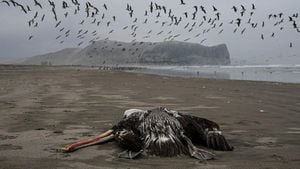A complex battle is brewing along the West Coast, pitting conservationists against wildlife management officials as they grapple with the invasive barred owl's impact on native bird species. The U.S. Fish and Wildlife Service has unveiled plans to significantly ramp up efforts to eliminate barred owls, citing their increasing numbers and adverse effects on struggling native owls, particularly the northern spotted owl and the California spotted owl. This controversial tactic is set to roll out next year across roughly 23,000 square miles of forested areas in California, Oregon, and Washington.
The plan, finalized on Wednesday, indicates the government’s intent to kill as many as 452,000 barred owls over the next 30 years. Areas like the Hoopa Valley Indian Reservation have conducted experimental killings of barred owls for over 15 years, experiencing some success of late. Despite past efforts, the barred owl continues to flourish, hindering conservation attempts for its native counterparts. Currently, around 100,000 barred owls overshadow the mere 7,100 northern spotted owls, leading to severe competition for resources and habitats.
Barred owls are not just pesky interlopers; their predatory behavior extends beyond just other owls. According to David Wiens, a scientist with the U.S. Geological Survey who directed previous barred owl removal studies, these birds feast on various small mammals, amphibians, and even other bird species. The encroachment of barred owls threatens not only the delicate balance among bird populations but could also devastate populations of frogs and salamanders, showcasing the far-reaching ecological consequences of this situation.
This initiative of eliminating one species to protect another evokes memories of past wildlife management actions, where similar drastic measures led to the culling of sea lions to save salmon populations or the extermination of cowbirds, known for laying eggs in the nests of warblers. Critics argue this approach may disproportionately affect the ecosystem and proves to be alarmingly intrusively human-driven intervention.
Federal officials suggest they have learned much from more than 4,500 barred owls removed since 2009. Still, there are significant concerns about how effective these measures can truly be. Experiments have exhibited mixed outcomes, making it difficult to ascertain whether this large-scale killing will result in any sustainable change.
Kent Livezey, a former biologist with the Fish and Wildlife Service, voiced concerns over the impending plan, highlighting the high costs and ethical dilemmas surrounding the mass killing of wildlife. He notes the over 100 bird species currently adapting to changing habitats and opposes government intervention, advocating for nature's natural course. "Should we be stepping in and killing mass numbers of them like this?" he questioned, emphasizing the complexity of human interventions.
The persistence of barred owls can be attributed to changes in their habitat, some rooted in human actions. Originally hailing from eastern North America, barred owls began moving toward the Pacific Northwest during the 1970s. Their population surged partly due to favorable climate changes and environmental modifications made by humans. The historical logging restrictions once aimed at protecting the spotted owl's habitat now create opportunities for new habitats suitable for barred owls. More than using bullets, the real challenge lies in addressing these environmental shifts.
The plan will see trained shooters carrying out the culling of barred owls, luring them with recordings simulating the calls of their species. Previous attempts to control their numbers through different methods— like capturing, euthanizing, and collecting eggs—were deemed too costly or impractical. Some wildlife advocates see the mass killing of barred owls as not just contradictory, but as creating distractions from the underlying threats facing native birds, including habitat loss due to logging practices. Wayne Pacelle of Animal Wellness Action points to this issue, arguing for simply relying on nature's balance without putting more pressure on certain species.
Despite the waves of criticism, Fish and Wildlife officials maintain their stance on combating the threat barred owls pose to native populations. Oregon state supervisor Kessina Lee framed the goal as one of urgent conservation, saying and asserting, “We’re still going to have barred owls in the West. This is really just about trying to prevent the extinction of spotted owls.”
The next steps get underway against the backdrop of heightened scrutiny concerning the ethical dimensions of culling wildlife to save another species. The reaction to the impending plan remains decidedly mixed among conservationists, scientists, and animal advocates. Some remain steadfastly against the killing, voicing their belief to find alternative adaptations to shifts within the ecosystem, demonstrating the continuing tug-of-war between the objective to conserve and the unintended consequences of interventions.
With such polarizing discussions around the impact of the planned measures, the dialogue within the conservation community is bound to evolve as stakeholders ponder the balance between ecological integrity and responsible wildlife management. Looking forward, the success of this ambitious initiative hinges on not only immediate results but on informed, long-term strategies toward coexistence and sustainable ecosystems.



